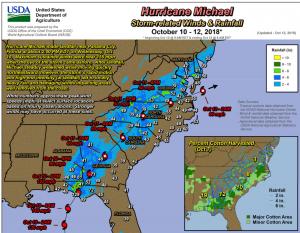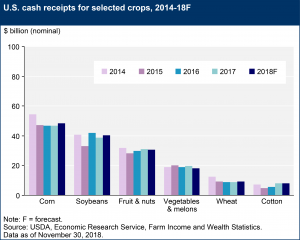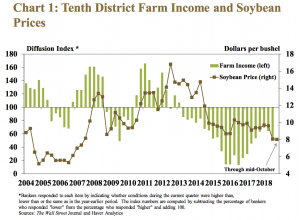Bloomberg's Leah Nylen reported Thursday that "a Colorado judge issued an order temporarily blocking the proposed $25 billion merger of Kroger Co. and Albertsons Cos., which has been challenged by…
Federal Reserve: Observations on the Ag Economy- November 2018
On Wednesday, the Federal Reserve Board released its November 2018 Beige Book update, a summary of commentary on current economic conditions by Federal Reserve District. The report included several observations pertaining to the U.S. agricultural economy.

* Sixth District- Atlanta– “Agriculture conditions across the District softened. In early October, Hurricane Michael caused significant wind and rain damage to agriculture production in the Florida panhandle, south Alabama, and south Georgia. Products affected included cotton, pecans, peanuts, fruit and specialty crops, timber, livestock, poultry, and green- house and nursery products.

“In spite of Hurricane Michael, cotton harvesting in Alabama and Georgia progressed close to their five-year averages, but with significant deterioration in conditions, especially in Georgia.

“The District’s soybean and peanut harvests were ahead of their five-year averages. Year-over-year prices paid to farmers in September were up for corn, cotton, rice, and beef, while soybean, eggs, and broiler prices were down.”
* Seventh District- Chicago– “Although the harvest took longer than normal, corn and soybean yields were quite large.

“And, in spite of low prices, crop producers’ incomes were better than what had been expected earlier this year.

“However, crop sales were lower than normal, and a record amount of the harvest was put into storage. This reflected in part higher prices for delivery in later months compared to prices for delivery at harvest. Logistical challenges continued as soybeans that would usually be exported to China were being sent to other markets. Farm equipment dealers reported giving large discounts in order to make sales as many crop farmers continued to face financial challenges. Hog and cattle prices moved higher during the reporting period, but milk prices floundered in part because of weak exports. Farm mediation services remained in demand for troubled operations.”
* Eighth District- St. Louis– “District agriculture conditions declined modestly from the previous reporting period. Corn, cotton, and soybean yields are expected to be higher than 2017 levels, while rice yields are expected to be lower. Contacts noted that unusually wet weather has impacted crop quality negatively this fall, which contributed to a deterioration in crop prices.
In addition, contacts expressed concern over the ongoing tariffs leveled at U.S. agricultural products. There are reports of storage shortages as soybeans that are normally exported to China are being stored in large quantities rather than exported.
* Ninth District- Minneapolis– “District agricultural conditions remained weak. According to results from the Minneapolis Fed’s third-quarter survey of agricultural credit conditions, roughly three in five lenders surveyed reported that farm incomes decreased in the third quarter relative to a year earlier, while a similar proportion reported decreased capital spending. While early indications were for very strong production in much of the District, in some areas heavy rains and unseasonably cold weather were complicating harvests.”
* Tenth District- Kansas City– “Farm income and credit conditions in the Tenth District weakened slightly from the last reporting period. Corn, wheat and cattle prices rose slightly. However, weakness in hog and dairy markets, significantly lower soybean prices, and trade uncertainty weighed on the agricultural outlook in the District.

“Expectations for farm income were lowest in Missouri and Nebraska, which are more concentrated in soybean production than other states in the District. Alongside lower farm income, repayment rates declined slightly and demand for farm loans increased modestly. In addition, producers’ working capital deteriorated moderately, and the share of farm borrowers planning to sell mid- to long-term assets increased from a year ago. Despite downward pressure from a weaker farm economy and modest increases in farm loan interest rates, farmland values decreased only slightly.”
* Eleventh District- Dallas– “Agricultural conditions improved further, with less than one percent of the state in drought as of mid-November. Ample rainfall has built up ground moisture reserves, boosting crop prospects for 2019.

“However, excessive precipitation in some areas has delayed planting of the winter wheat crop and caused some quality issues for cotton. Overall, agricultural producers were quite optimistic, although some continued to experience financial difficulty from drought conditions earlier in the year.”
* Twelfth District- San Francisco– “Conditions in the agriculture sector improved modestly. Profits at beef and pork producers rose noticeably on a year-over-year basis, due to strong domestic demand. A contact in Central California reported that yields were generally solid but that trade policy uncertainty continued to limit the ability of growers to secure longer-term sales contracts. Potato and wheat yields in the Mountain West were strong, though exports of these products declined moderately. Drier-than-usual conditions in parts of California lowered yields for select crops, like nuts and tomatoes, but contacts noted that inventories were at an adequate level to meet demand.”





